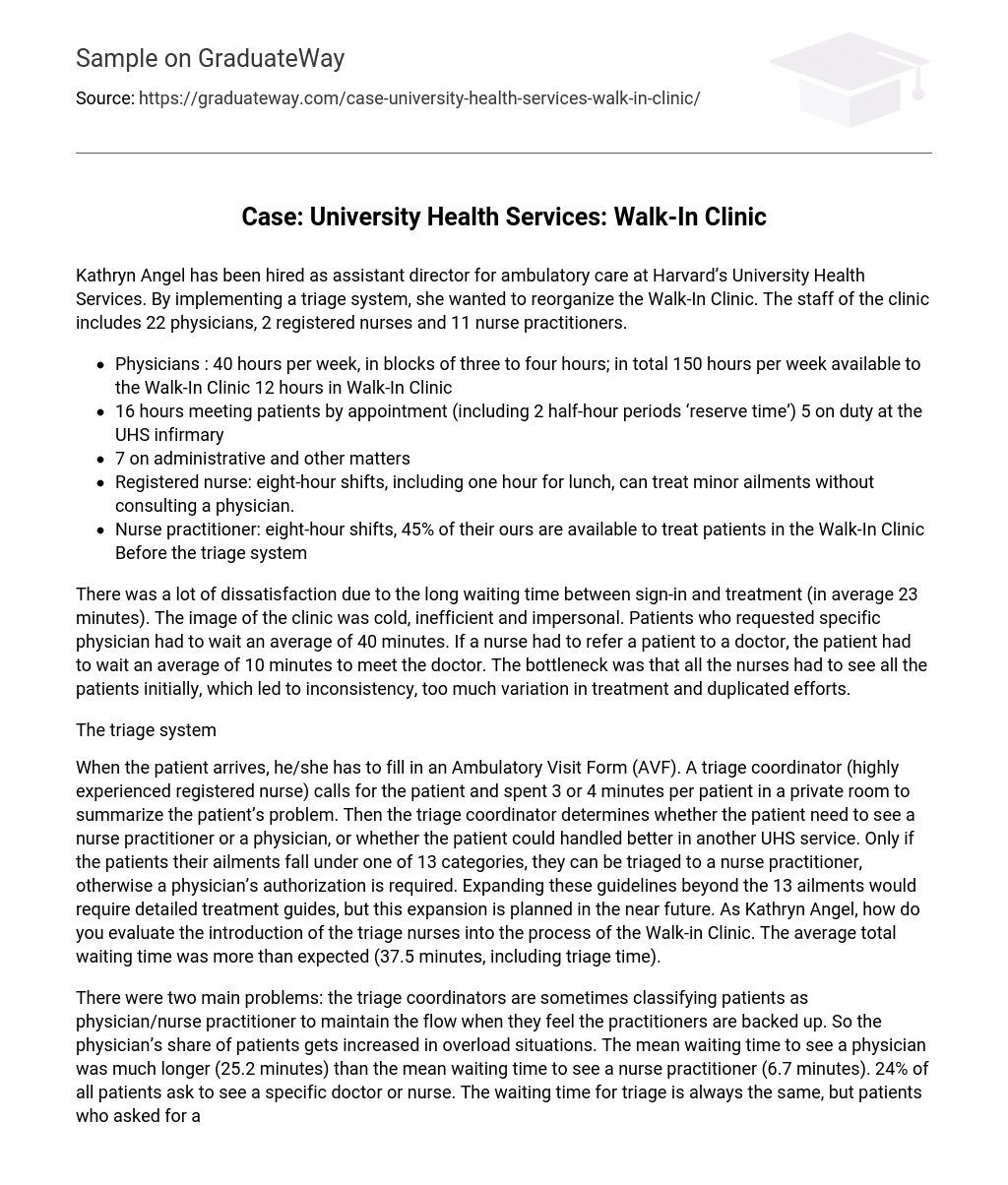Kathryn Angel has been hired as assistant director for ambulatory care at Harvard’s University Health Services. By implementing a triage system, she wanted to reorganize the Walk-In Clinic. The staff of the clinic includes 22 physicians, 2 registered nurses and 11 nurse practitioners.
- Physicians : 40 hours per week, in blocks of three to four hours; in total 150 hours per week available to the Walk-In Clinic 12 hours in Walk-In Clinic
- 16 hours meeting patients by appointment (including 2 half-hour periods ‘reserve time’) 5 on duty at the UHS infirmary
- 7 on administrative and other matters
- Registered nurse: eight-hour shifts, including one hour for lunch, can treat minor ailments without consulting a physician.
- Nurse practitioner: eight-hour shifts, 45% of their ours are available to treat patients in the Walk-In Clinic Before the triage system
There was a lot of dissatisfaction due to the long waiting time between sign-in and treatment (in average 23 minutes). The image of the clinic was cold, inefficient and impersonal. Patients who requested specific physician had to wait an average of 40 minutes. If a nurse had to refer a patient to a doctor, the patient had to wait an average of 10 minutes to meet the doctor. The bottleneck was that all the nurses had to see all the patients initially, which led to inconsistency, too much variation in treatment and duplicated efforts.
The triage system
When the patient arrives, he/she has to fill in an Ambulatory Visit Form (AVF). A triage coordinator (highly experienced registered nurse) calls for the patient and spent 3 or 4 minutes per patient in a private room to summarize the patient’s problem. Then the triage coordinator determines whether the patient need to see a nurse practitioner or a physician, or whether the patient could handled better in another UHS service. Only if the patients their ailments fall under one of 13 categories, they can be triaged to a nurse practitioner, otherwise a physician’s authorization is required. Expanding these guidelines beyond the 13 ailments would require detailed treatment guides, but this expansion is planned in the near future. As Kathryn Angel, how do you evaluate the introduction of the triage nurses into the process of the Walk-in Clinic. The average total waiting time was more than expected (37.5 minutes, including triage time).
There were two main problems: the triage coordinators are sometimes classifying patients as physician/nurse practitioner to maintain the flow when they feel the practitioners are backed up. So the physician’s share of patients gets increased in overload situations. The mean waiting time to see a physician was much longer (25.2 minutes) than the mean waiting time to see a nurse practitioner (6.7 minutes). 24% of all patients ask to see a specific doctor or nurse. The waiting time for triage is always the same, but patients who asked for a specific provider had to wait an average of 8.6 minutes longer. Two of the five doctors on duty are 100% occupied with ‘walk-in appointments’. So the available MD resources decrease by 40% and fills up the waiting room. People want a practitioner who knows them well, but the aim of the UHS Walk-In Clinic is to provide the best possible care to all their patients, particularly those whose medical needs are almost urgent.
How can the waiting times be improved and the complaints be reduced? First of all, they need to expand the 13 nurse practitioner guidelines and they also have to define further the roles of nurse practitioner and physician.
The UHS always had a philosophy of not trying to tell physicians how to practice medicine, but many patients only want to see their doctor. Furthermore, doctors also encourage their patients to meet them in the Walk-In Clinic, what’s not the purpose of the UHS concept.
Other potential alternatives are:
- educate the public on the separate purposes and missions of doctor appointments and the Walk-In Clinic
- ask the triage coordinators to be a little more aggressive (ask if they really need a specific person and suggest alternatives)
- establish a firm policy of not accepting specific physician requests in the Walk-In Clinic





